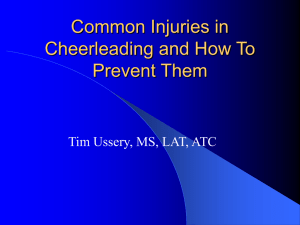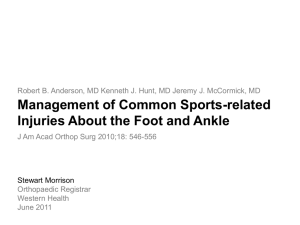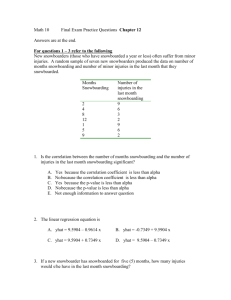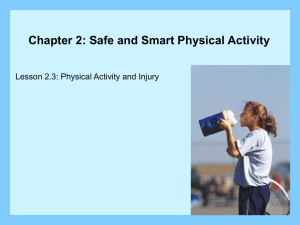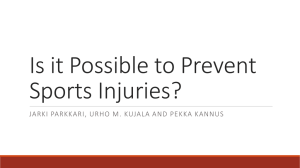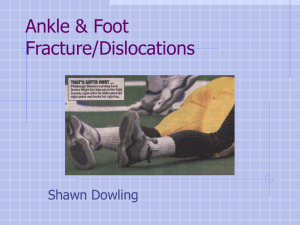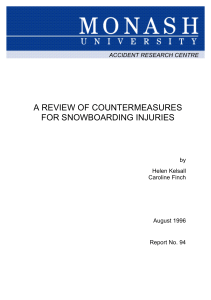Snowboarding Injuries
advertisement
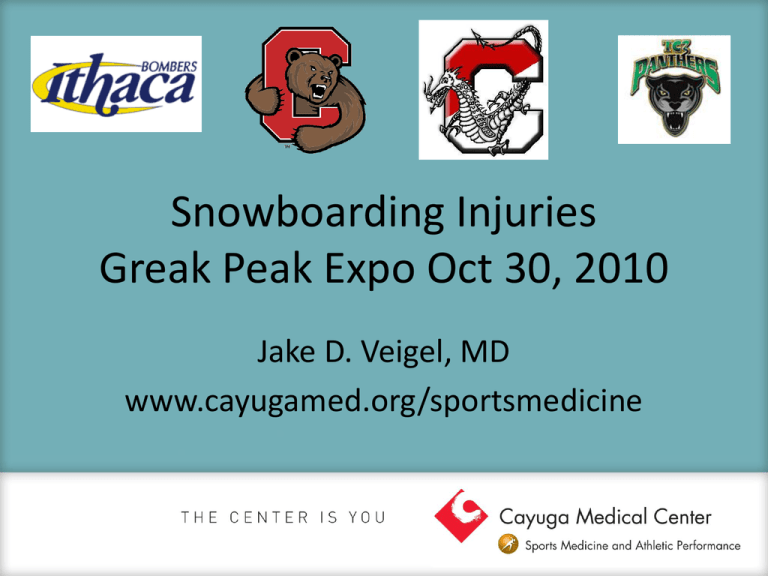
Snowboarding Injuries Greak Peak Expo Oct 30, 2010 Jake D. Veigel, MD www.cayugamed.org/sportsmedicine My Experience • Residency training in Ogden, UT • Sports medicine training at UMass Objectives • Briefly review history of snowboarding • Review common injuries seen in snowboarding History • 1965 “the Snurfer” Sherman Poppen • 1969 “the Winterstick” Dimitrije Milovich • 1977 Jake Burton and Tom Sims • 1998 snowboarding in Nagano Olympic games • Fastest Growing winter sport Who Rides? • • • • • Age 25-34: 41 % Age 35-44: 14 % Age 45-54: 6 % Age 55-64: 3 % Age 65+: 2 % Equipment • • • • The board The boots The bindings The body Injuries • Lower extremity – Both feet firmly attached to board (less twisting of legs/knees) – Snowboard shorter than skis (shorter lever arm) – Usually softer boots (less ankle protection, less force transmitted to knee) – Less ACL, more ankle injuries Injuries • Upper extremity injuries – No poles – Feet perpendicular to direction of movement – Can’t stabilize by moving leg out – Fall backward (heel side) or forward (toe side) without poles to break fall – Wrist and shoulder injuries instead of skier‟s thumb Snowboarding Injuries • Most common sites of injury: 23% wrist 17% ankle 16% knee 9% head 8% shoulder 8% trunk 4% elbow 7% other Young AFP 1999 Snowboarding Injuries • 45% beginners • 31% intermediate • 23% expert Upper Extremity • Fractures (56%) > sprains (27%) > dislocations (10%) > contusions (6%) • Fractures: radius (esp. distal) > carpal bones (esp. scaphoid) > clavicle > humerus > ulna • Dislocations/subluxations: glenohumeral and acromioclavicular > elbow joints Wrist injuries • Wrist injury more common with a backward (heel side) fall – 75% of wrist fractures • Shoulder injury more common with a forward (toe side) fall 12 year old snowboarder Treatment for Distal Radius Fractures • • • • Evaluate alignment Initially splinting Casting for 4-6 weeks Followed by protective splinting Scaphoid Fracture • Most common fractured bone in the wrist • Peanut shaped bone that spans both row of carpal bones • Does not require excessive force and often not extremely painful so can be delayed presentation 21 year old snowboarder Scaphoid Fracture Treatment • Cast 6-12 weeks • Short arm vs. long arm • Follow patient every 2 weeks with x-ray • CT and clinical evaluation to determine healing • Consider surgery early Wrist Injury Prevention • Snowboarders with wrist guards ½ as likely to be seen for wrist injury • Large proportion of snowboarders do not use any protective equipment Russell CJSM 2007 Neidfelt CJSM 2008 Snowboarding Ankle Injuries • 2nd most commonly injured site • 12-38% of snowboarding injuries vs. 5-6% of skiing injuries • Leading leg (62-91%) > trailing leg • Sprains 52%, fractures 44% Snowboarder’s Fracture • Fracture of the lateral process of the talus • Rare injury before snowboarding: – <0.9% of ankle injuries – high energy trauma • In snowboarding: – – – – 2.3% of all injuries 15% of ankle injuries 34% of ankle fractures 95% of talus fractures Snowboarder’s Fracture • Hawkins 1965 reported 13 cases of fractures of the lateral process of the talus • MVA or fall from height • Patients reported dorsiflexion and inversion at the time of injury Snowboarder’s Fracture • Dorsiflexion and inversion has been the commonly accepted mechanism • In snowboarding: landing after an aerial maneuver How it Happens? Funk AJSM 2003 Snowboarder’s Ankle • Ride with knees slightly flexed and ankles dorsiflexed, especially when riding toeside • Forward fall parallel to the direction of the board • Leading leg rotates toward the front of the board everting the dorsiflexed ankle • Board acts as a lever about the long axis of the foot, increasing torque Snowboarder’s Fracture • Three types A. Type 1, a chip fracture B. Type 2, simple C. Type 3, comminuted Snowboarders Ankle? • Anterolateral ankle pain, similar to an ankle sprain • May be occult or inconspicuous on radiographs • 40% missed at initial presentation • May be seen better with CT or MR Snowboarder’s Ankle Treatment • Casting and nonweightbearing • If type 2 or 3, then surgery if needed Prognosis • Early diagnosis important to decrease the risk of persistent pain from nonunion, malunion or subtalar osteoarthritis • Even with treatment, approximately 25% have pain at follow up Happy Riding
